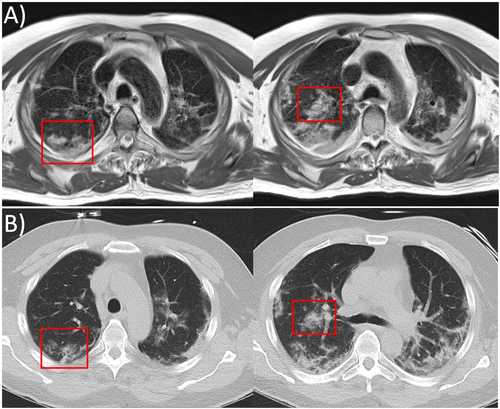0.55T MRI Performs Comparably to CT with COVID-19 Imaging
Research MRI images reveal information in 61-year-old COVID-19-positive patient that is similar to that captured by CT.
High-performance, low-field MRI can offer radiologists an equivalent level of detail to CT with patients who have tested positive for COVID-19 infection. Images captured with a 0.55T MRI reveal the diagnostic capability of these studies.
Researchers from the National Heart, Lung, and Blood Institute National Institutes of Health (NHLBI) conducted a study with a 61-year-old COVID-19-positive patient to test how well the research MRI would perform. They published their results this week in Radiology.
Two axial slices from, A, 0.55T MRI (prototype MAGNETOM Aera, Siemens Healthineers, Erlangen, Germany) with spatial resolution 1.2mm x 1.2mm x 6mm (respiratory gated fast-BLADE turbo spin echo acquisition, TE/TR= 48ms/3471ms respiratory interval, acquisition time = 5min 15s) and, B, CT (SOMATOM Force, Siemens Healthcare, Erlangen, Germany) reformatted to 0.6mm x 0.6mm x 6mm spatial resolution. Multifocal lesions equivalent to ground glass opacities on CT and peripheral distribution of consolidative opacities characteristic of COVID-19 are observed using both imaging modalities. In some regions, the severity of the abnormality appears worse on MRI, as shown in the red boxes. Credit: RSNA

“This case demonstrates the capability of this MRI system configuration, compared with CT, for imaging COVID-19,” said the team led by Adrienne E. Campbell-Washburn, Ph.D., who leads the NHLBI MRI Technology program.
On days 15 and 16 after the patient’s symptoms emerged, Campbell-Washburn’s team conducted chest CT scans, as well as 0.55T research MRI with fast-BLADE turbo-spin echo acquisition, gated to end-expiration. The MRI images had intermediate image weighting between proton density and T2. In addition, the team said, they reformatted the CT images to match the slide orientations and thickness of the MRI images in order to accurately compare them.
Based on their image analysis, they determined that the MRI-provided information was similar to that gathered from the CT scans. With the MRI studies, the team was able to visualize multi-focal lesions – predominantly in the upper lobes – that were equivalent to ground-glass opacities, as well as peripheral distribution of consolidations predominantly in the lower lobes. This was characteristic of COVID-19 infection, they said.
Existing studies have demonstrated the utility of ultra-short TE 3T imaging and 0.55T MRI with COVID-19 infection and recovery. These findings show that lower-field MRI that has both high performance hardware and software can potentially reduce distortion for lung MRI, increase accessibility to these types of studies.
For more coverage based on industry expert insights and research, subscribe to the Diagnostic Imaging e-Newsletter here.
New MRI Research Explores Links Between Waist-to-Hip Ratio and Memory in Aging
March 13th 2025Researchers found that a higher waist-to-hip ratio in midlife was associated with higher mean diffusivity in 26 percent of total white matter tracts in the cingulum as well as the superior and inferior longitudinal fasciculus.
New Analysis Forecasts Substantial Cost Savings with the Use of Photon Counting CT for CCTA
March 8th 2025The use of ultra-high-resolution photon-counting CT in the evaluation of stable chest pain may significantly reduce follow-up tests and invasive coronary angiography (ICA) procedures, possibly resulting in millions in health-care cost savings, according to a cost-effectiveness analysis presented recently at the European Congress of Radiology.